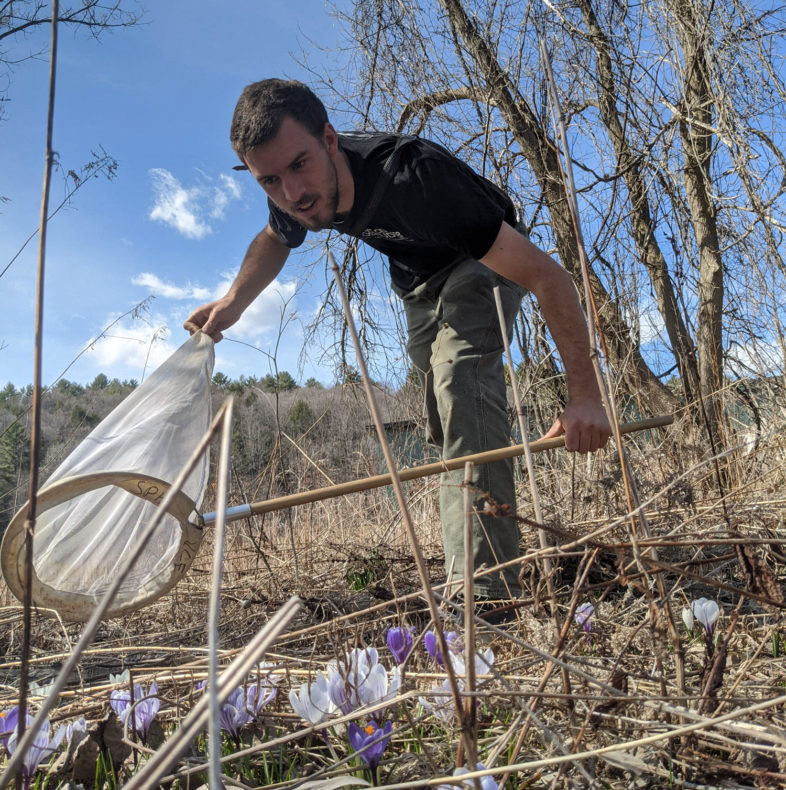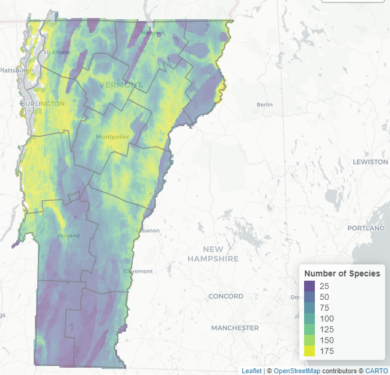
VCE bee biologist Spencer Hardy attempts to net a bee during one of many surveys. © Jacqueline Huettenmoser
This article is the third in a series highlighting projects made possible by generous contributions to VCE’s ALL IN for Biodiversity campaign.
The ALL IN for Biodiversity campaign is expanding VCE’s capacity and conservation impact by investing in pioneering science, collaborating for conservation outcomes, and broadening our vision for community science. Your ALL IN for Biodiversity gift makes this possible.
_______________________________
For over a decade, VCE has been positively buzzing with activity, surveying far and wide for bee species across the state. Our efforts kicked off with the Bumblebee Atlas in 2012 and reached a crescendo in 2022 with the State of Vermont’s Wild Bees (State of Bees) report. Little did we know that this would start a multi-state ripple of pollinator work. Although VCE’s “bee team” isn’t new, much of the research that made the State of Bees report possible was supported in part by the ALL IN for Biodiversity campaign. VCE’s bee-focused studies—past and present—exemplify the power of long-term monitoring coupled with community science to yield invaluable data for conservation.
“The Bumblebee Atlas led to several bee species being listed in the 2015 Vermont Wildlife Action Plan and also helped us get the funding we needed to start our statewide bee survey in 2019,” VCE biologist Spencer Hardy recounts. The goals of the Vermont Wild Bee Survey were to determine how many species exist in the state, identify where they are found, and produce a robust report to guide conservation action.
A statewide bee survey is no easy task, and it begs the question: Where does one find a species of bee not yet discovered in Vermont? Well, there are straightforward places to look like a patch of sunflowers in Burlington or the wetlands of Missisquoi National Wildlife Refuge. Then there are the less obvious spots, like in a random roadside ditch. These are all real locations where Hardy and former VCE biologist Nathaniel Sharp discovered species new to the state.
During the five-year Vermont Wild Bee Survey, VCE biologists and volunteers discovered 20% of Vermont’s 352 currently-known bee species for the first time and documented ranges for many others. VCE Conservation Biologist Kent McFarland was head of the project and got the idea after observing a common hole in datasets across the state. “Invertebrate species, in general, are massively under-surveyed. Important pollinators like bees can have a major influence on ecosystems and crops. How can we conserve these insects if we don’t even know what’s here in our own state?” McFarland explains.
Surveys like this are crucial because they not only help us learn what species are right in our backyard but also help us identify high-priority areas to conserve. With a clear picture of which bees live where, conservation professionals can make sound decisions, even as the climate changes. In late 2022, the Bumblebee Atlas and Vermont Wild Bee Survey culminated in the State of Vermont’s Wild Bees report, which identifies 55 species and 12 Important Bee Areas as high conservation priorities.

This map shows the number of bee species across Vermont, with dark purple on the lowest end and bright yellow-green on the highest. Vermont county lines are marked in black. For an interactive version, please visit the State of Vermont’s Wild Bees report. Figure credit to Michael Hallworth
Since the report’s release, VCE’s bee team has had no shortage of work. Over the past several years, this project has garnered interest from across Vermont and beyond. Through the Vermont Pollinator Working Group, VCE has joined forces with the University of Vermont Extension and the Vermont Bee Lab to gather a wide range of stakeholders from across the state and broader Northeast region. The working group has created an education campaign for Vermont farmers, is working to restrict certain pesticides that harm bees, and is evaluating the scientific foundation of a proposed bill banning specific chemicals, which is currently making its way through Vermont’s State House.
McFarland, who has been studying pollinators in Vermont for decades, provided official testimony stating, “Some bumblebees in Vermont have had a marked decline in the last 30 years, likely due to multiple stressors. One of these stressors is pesticides.” McFarland continues, “Neonicotinoids are known to cause both lethal and sublethal harm to wild bees and other pollinators. Addressing the use of this stressor on pollinator populations and other insects is an important step for their conservation.” You can read the full testimony in this article.
Beyond the Northeast, other states—Washington, California, and Texas—have joined forces with our scientists to work on a national bee assessment in their own regions. This nascent project will synthesize raw bee occurrence data from projects like the Vermont Wild Bee Survey and generate conservation ranks for species. As Hardy explains: “By ranking bee species, state and regional planners who might not have the resources to complete their own bee surveys can develop comprehensive conservation strategies that support species of most concern.”
We’re thrilled that our work has become a standard for others to emulate, and we hope that someday, every state will have a program to document and conserve its bee diversity.
You can read all the articles in this series here.
Watch Episode 2 of Conservation Coffee Hour, featuring a conversation between Susan and Spencer about Vermont’s wild bees.
_______________________________
VCE is all in for biodiversity. Will you join us by participating in one of our projects or making a special gift to the ALL IN for Biodiversity campaign?
